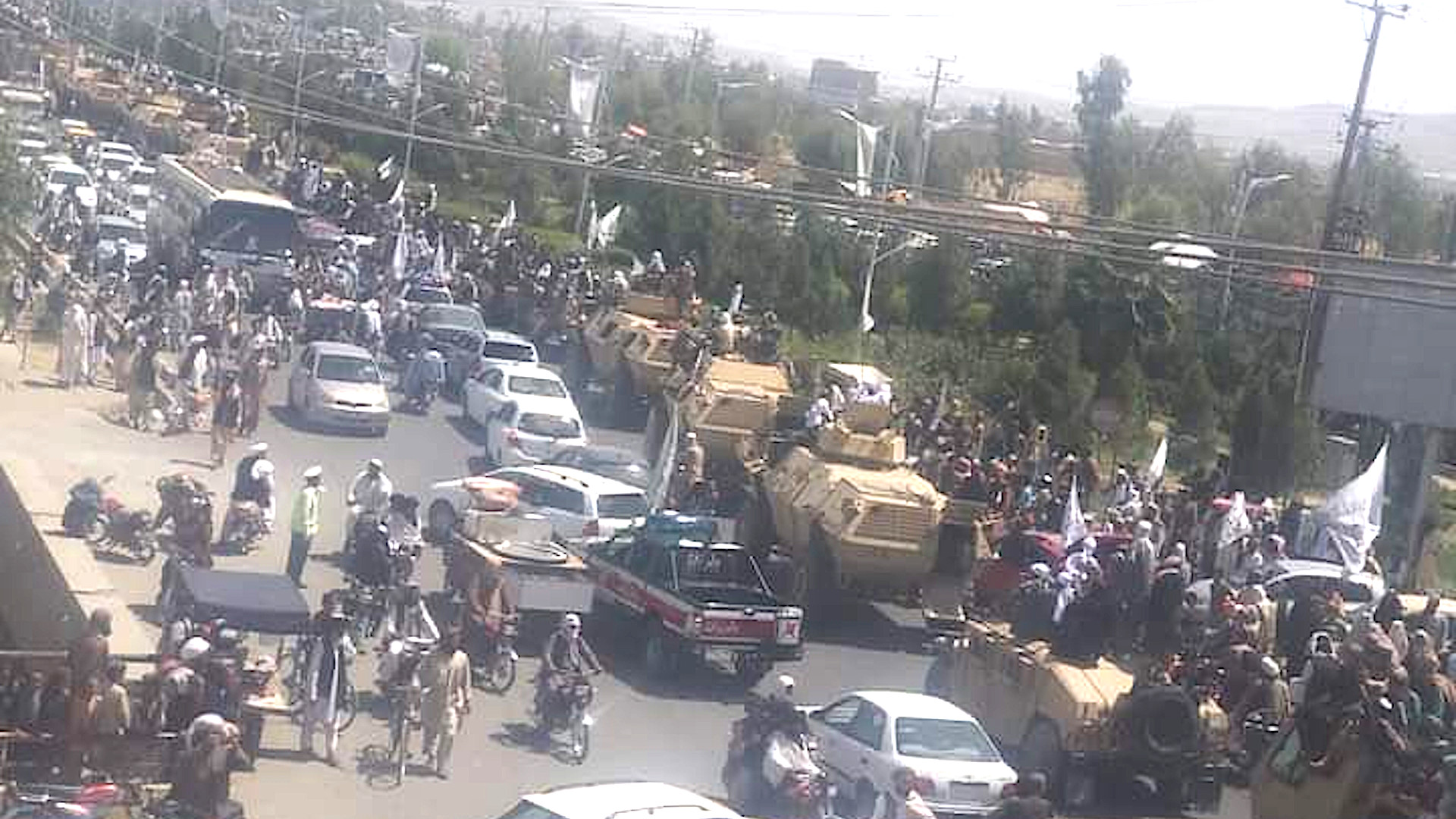The Taliban held an absolutely massive victory parade in the Afghan city of Kandahar today, involving dozens of U.S.-supplied vehicles that the group captured from the former Afghan National Defense and Security Forces as it seized control of the country. At least one ex-Afghan Air Force UH-60 Black Hawk helicopter flew overhead during the procession, which took at least 35 minutes to pass by in its entirety. Mullah Hibatullah Akhundzada, the Taliban’s current supreme leader, or Emir, was widely expected to make an appearance at a following rally, but did not.
The Taliban first emerged in 1994 and Kandahar, which is the capital of the Afghan province of the same name, holds special significance for the group. In September 1996, they declared the establishment of the Islamic Emirate of Afghanistan and that this city was its capital. Kandahar Province’s Khakrez District is also the birthplace of Mullah Mohammed Omar, the founder of the Taliban and its first supreme leader until his death in 2013.

Now, almost 25 years later, and nearly two decades after the Islamic Emirate was toppled by the United States, it is hardly surprising that the triumphant Taliban would head here to mark its return to power.
The parade included a variety of different captured U.S.-supplied vehicles, including Navistar MaxxPro Mine-Resistant Ambush-Protected (MRAP) armored trucks, up-armored Humvees, Ford and Toyota pickup trucks, and Navistar 7000-series trucks. At least one of the Navistar 7000s had a 122mm D-30 howitzer on its rear bed. Other vehicles in the procession had various weapons mounted, as well, including a number of Humvees carrying 23mm ZU-23-2 automatic cannons.
There was also a line of Mobile Strike Force Vehicle (MSFV) light armored vehicles. The 4×4 MSFV design was developed specifically for the Afghan military, through a contract with the U.S. military, and was derived from the U.S. Army’s M1117 Armored Security Vehicle (ASV) armored car.
As already noted, a UH-60 helicopter was also seen flying overhead during the parade. Video had emerged last week reportedly showing a Black Hawk under Taliban control taxiing on the ground at the airport in Kandahar. Earlier this week, additional footage appeared that was reported to show one of these helicopters flying over Kandahar. It’s possible that all of these clips show the same helicopter.
An individual was seen suspended below the helicopter in multiple clips of the earlier flight this week and it remains unclear why. Despite reports that this was a person being brutally handed, multiple videos appear to show the person moving freely in what looks to be a harness of some kind. There was at least one report that the Taliban was trying to use this combination to hang the group’s flag on top of a building.
The Taliban have captured dozens of former Afghan military aircraft in various conditions. This including dozens of planes and helicopters at Hamid Karzai International Airport in Kabul, which the U.S. military said it disabled in unspecified ways ahead of the final historic withdrawal of American troops from the country this week.
The ability of the Taliban to operate and maintain any of the aircraft it has captured, but especially more modern U.S.-financed platforms that the Afghan Air Force had acquired, such as the UH-60s and A-29 Super Tucano light attack aircraft, remains to be seen. The War Zone
has explored these issues in detail previously. However, it is clear that the Taliban have been able to find the means necessary to fly at least one Black Hawk, something that is, at best, a highly embarrassing visual for the United States.
The group had also seized hundreds of vehicles, as well as troves of small arms, light weapons, and other materiel from Afghan government security forces in the weeks leading up to the fall of Kabul and the final collapse of the Islamic Republic of Afghanistan last month. Parades like the one today in Kandahar are clearly meant to further underscore the Taliban’s victory over the former Afghan government and its American benefactors and highlight the very real spoils of war the group has obtained as a result.
At the same time, the Taliban now faces its own challenges in governing. A nascent anti-Taliban resistance has emerged in the Panjshir Valley north of Kabul and Afghanistan’s branch of ISIS is as opposed to the Islamic Emirate as it is to the United States. There appears to be no massive rush by foreign countries to recognize the Taliban’s new leadership as the rightful rulers of Afghanistan, either, despite the group actively seeking out such ties.
Haji Yusuf Wafa, the Taliban’s new governor Kandahar, who led the rally after the parade, reiterated a promise of a general amnesty to former officials who had served the Islamic Republic. The Taliban has previously said that it wants to block Afghans from leaving the country, ostensibly to prevent a brain drain and help get their new Islamic Emirate on its feet. Of course, there have already been multiple, credible reports that the Taliban has been hunting down and executing opponents of its new regime and others as it reinstitutes extremely hardline policies, such as bans on music and the public display of pictures.
If nothing else, as the Taliban works to consolidate and legitimize its rule, it seems likely that we will see more parades that underscore its military prowess to maintain control.
Contact the author: joe@thedrive.com
